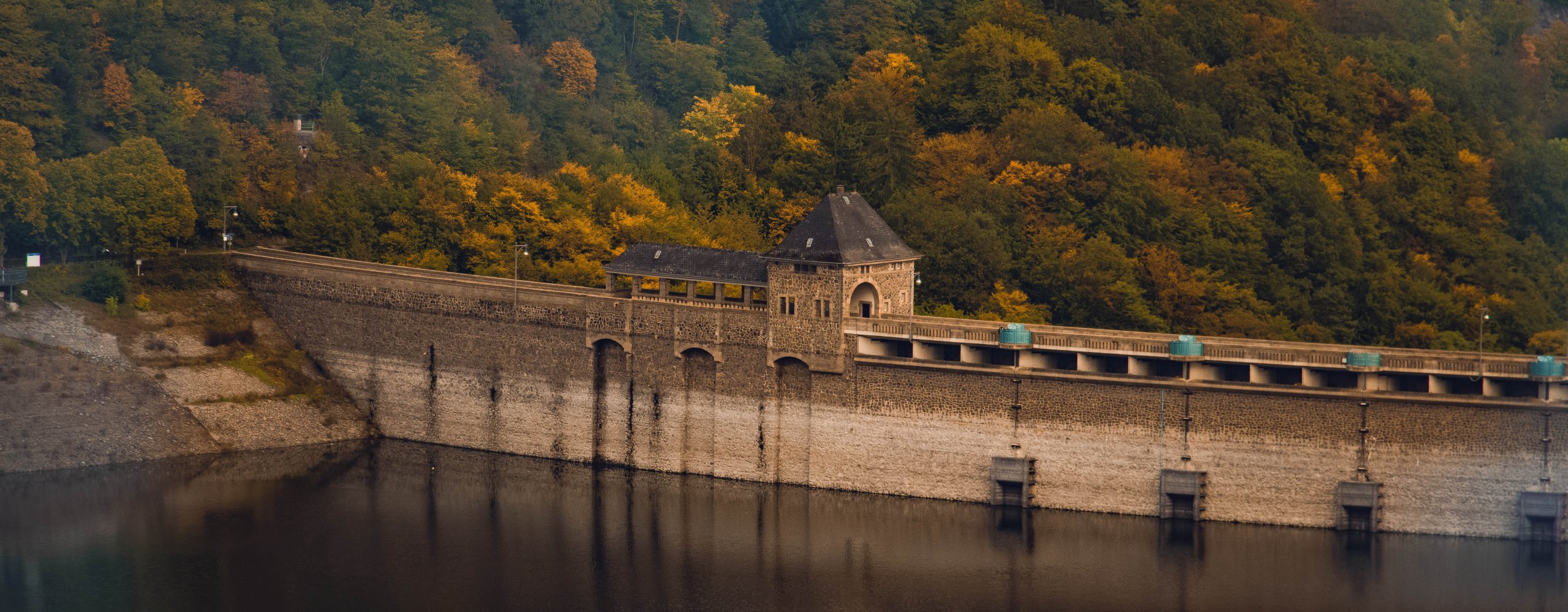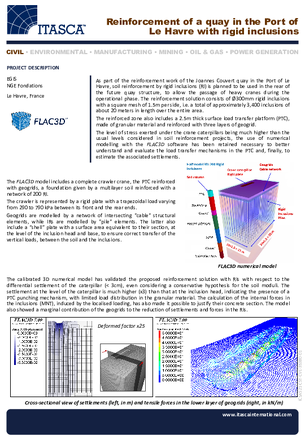
Reinforcement of a quay in the Port of Le Havre with rigid inclusions (2023)
As part of the reinforcement work of the Joannes Couvert quay in the Port of Le Havre, soil reinforcement by rigid inclusions (RI) is planned to be used in the rear of the future quay structure, to allow the passage of heavy cranes during the operational phase.
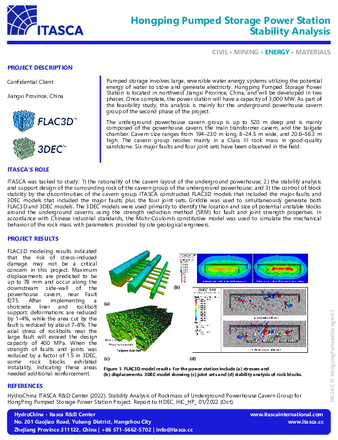
Hongping Pumped Storage Power Station Stability Analysis (2022)
Hongping Pumped Storage Power Station is located in northwest Jiangxi Province, China. Once complete, the power station will have a capacity of 3,000 MW. ITASCA's analysis focused on the underground powerhouse cavern group of the second phase of the project. The cavern group resides mainly in a Class III rock mass in good-quality sandstone. Six major faults and four joint sets have been observed in the field.
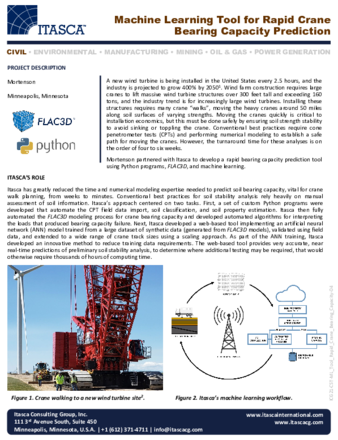
Machine Learning Tool for Rapid Crane Bearing Capacity Prediction (2021)
Wind farm construction requires large cranes to lift massive wind turbine structures over 300 feet tall and exceeding 160 tons. Installing these structures requires many crane “walks”, moving the heavy cranes around 50 miles along soil surfaces of varying strengths. Moving the cranes quickly is critical to installation economics, but this must be done safely by ensuring soil strength stability to avoid sinking or toppling the crane. Conventional best practices require cone penetrometer tests (CPTs) and performing numerical modeling to establish a safe path for moving the cranes requires on the order of four to six weeks. Itasca developed a rapid bearing capacity prediction tool using Python scripts, FLAC3D, and machine learning to provide near real-time feedback on the soil bearing capacity at a location, allowing enhanced crane walk planning.
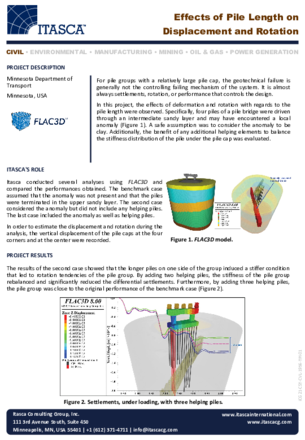
Effects of Pile Length on Displacement and Rotation (2021)
For pile groups with a relatively large pile cap, the geotechnical failure is generally not the controlling failing mechanism of the system. It is almost always settlements, rotation, or performance that controls the design.
In this project, the effects of deformation and rotation with regards to the pile length were observed. Specifically, four piles of a pile bridge were driven through an intermediate sandy layer and may have encountered a local anomaly (Figure 1). A safe assumption was to consider the anomaly to be clay. Additionally, the benefit of any additional helping elements to balance the stiffness distribution of the pile under the pile cap were evaluated.
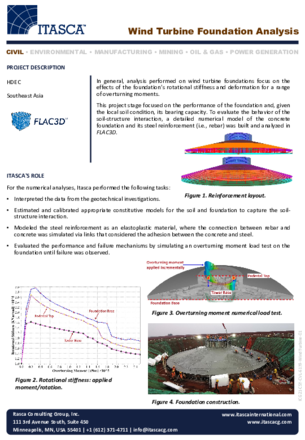
Wind Turbine Foundation Analysis (2021)
In general, analysis performed on wind turbine foundations focus on the effects of the foundation’s rotational stiffness and deformation for a range of overturning moments. This project stage focused on the performance of the foundation and, given the local soil condition, its bearing capacity. To evaluate the behavior of the soil-structure interaction, a detailed numerical model of the concrete foundation and its steel reinforcement (i.e., rebar) was built and analyzed in FLAC3D.

Seismic Performance of the OPC Puerto Cortes Container Terminal in Honduras (2019)
Itasca conducted a seismic performance evaluation of the trestle‐wharf section of the OPC Puerto Cortes Container Terminal, located in Honduras. A FLAC3D analysis of the soil is performed, including the piles and deck of the terminal. This is a fullycoupled, dynamic, soil‐structure, time‐history analysis that quantifies the performance and potential risks for the structure and slope. The Finn model – Byrne formulation was utilized using data from investigation boreholes.

Penetration of a Single Steel Foundation Pin in a Granitic Rock (2018)
The development of a subsea tidal turbine requires specific research work concerning the design of the foundation in contact with the seabed. This design stage can be simplified by the use of numerical modelling and more particularly by using discrete modelling. HydroQuest asked Cathie Associates to check their previous calculations regarding the behavior of a single steel foundation pin in a granitic rock mass by using Itasca’s discrete numerical approach and follow the forces applied to the pin as well as the state of the damaged zone around the tip during penetration.

Modelling over-boring and extension of a tunnel with surrounding excavations (2018)
As part of phase four in the extension of the ANDRA Meuse/Haute-Marne Underground Research Laboratory, a safety niche (called GT1) will be over-bored into a larger section, then extended. The tunnel axis is 16 m from an auxiliary shaft (named PX). Two perpendicular drifts, called GLN and GLE, connect these 2 excavations.

Junction Dam (2018)
Built between 1959 and 1961, Junction Dam is a double-curvature concrete arch dam located on Silver Creek in El Dorado County, California, just downstream from where Little Silver Creek and South Fork Silver Creek merge. The dam is in a relatively narrow canyon with steep sides and retains the Junction Reservoir.

Liquefaction Risk Mitigation using Jet Grouting and Earthquake Drains (2017)
Boldwing Continuum Architects Inc. has contracted Itasca Consulting Group to perform a liquefaction analysis and evaluate several soil improvement designs for the Langdale Ferry Terminal Project in Vancouver, Canada. The terminal sits on a deltaic granular deposit prone to liquefaction. The new expansion of the ferry terminal has to be designed in compliance with the 2017 Canadian Building Code, which requires the analysis of 11 different earthquake time histories. The most challenging requirement is to design the ground improvement to limit any lateral soil spreading within 100-150 mm.

Investigating the mechanical behavior of a surface repository for low and intermediatelevel short-lived radioactive waste (2017)
Andra operates a surface repository in Aube (“CSA”, North‐Eastern France), where some of the concrete canisters containing low and intermediate‐level short‐lived radioactive waste are stacked in concrete structures, then filled with gravel (Fig 1). ITASCA Consultants SAS, together with EGIS Industries, has studied the mechanical behavior of the assemblies, in the framework of design and safety demonstration programs.

Seismic Deformation Analyses of a Hydraulic Fill Embankment Dam (2017)
As part of evaluation of seismic performance of this 175-foot high hydraulic fill dam located at a confidential site in the southeast Appalachia region, Geosyntec hired Itasca Consulting Group (Itasca) to perform deformation analyses for seismic loading of the dam using numerical modeling. Prior to the deformation analyses, Itasca also assisted Geosyntec with numerical simulations to assess the liquefaction potential of the dam using the cyclic stress ratio approach.

Modelling concrete slab on rigid inclusion reinforced soil (2017)
In the context of a wine cellar extension project, a 20cm thick concrete slab is to be constructed on a soil reinforced by rigid inclusions. Itasca France has been called by the design office to verify the mechanical resistance of the concrete slab and assess its settlement under a uniform load.

Dynamic Soil Structure Interaction Analyses of North Shore Pump Station (2017)
Located near Fisherman’s Wharf in San Francisco, North Shore Pump Station is a part of the North Point Wet-Weather Facility (NPF), which provides primary treatment for disinfection of wastewater. The facility is a two-story building that is completely embedded in soil, and the subsurface conditions include potentially liquefiable sand layers and soft Bay Mud deposits sitting on bedrock sloping toward the east side waterfront. The building is supported by piers extending all the way into the Franciscan Complex bedrock.

Parking Ramp over Light Rail Station (2016)
A parking ramp expansion has been proposed at Terminal 1-Lindbergh to be constructed over the north end of the Metro Transit Light Rail (LRT) station. Itasca assessed the magnitude of the principal impacts by conducting three-dimensional geostructural analyses of the LRT station using 3DEC. Of the six designs evaluated, all but one option were predicted to be geostructurally feasible.
